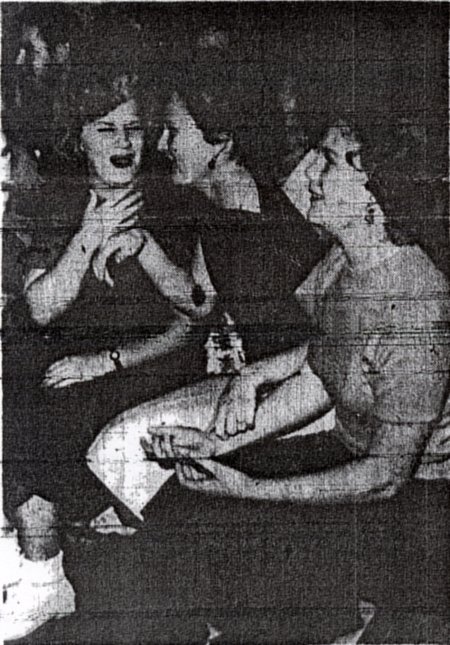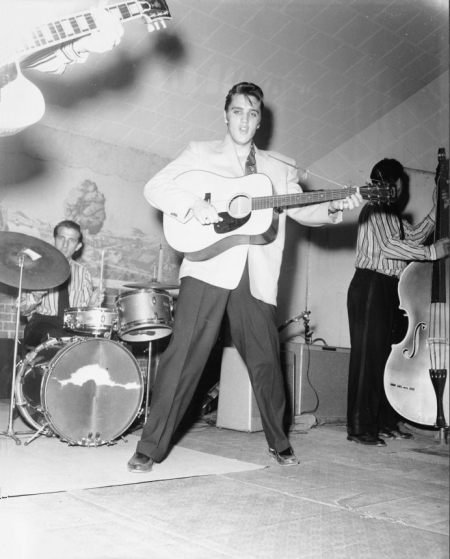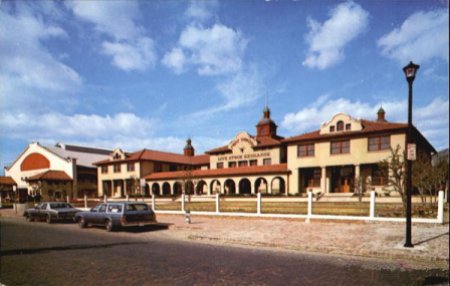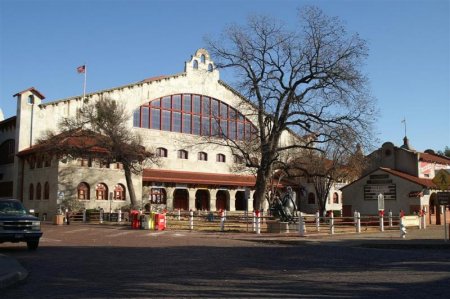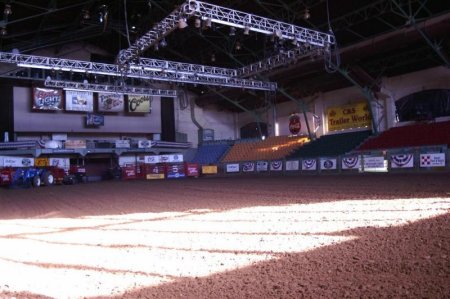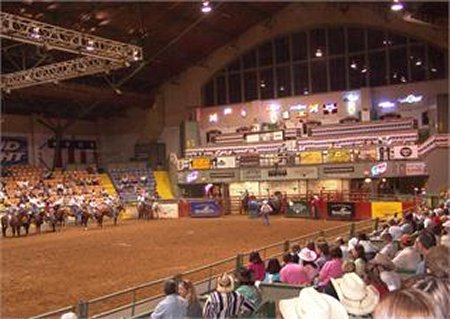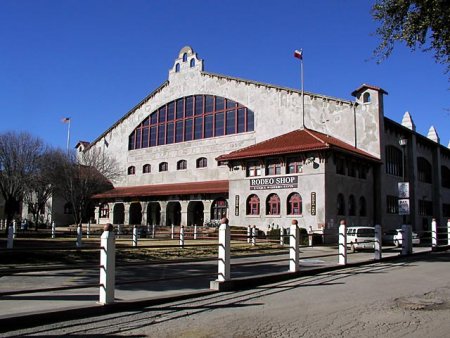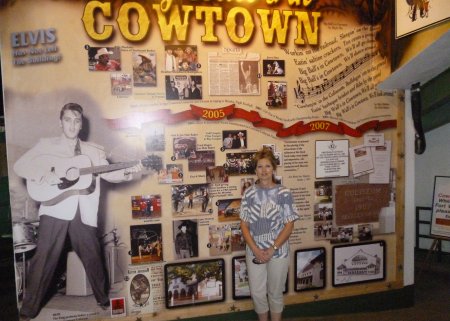 |
North Side Coliseum Fort Worth, Texas, was established in 1849 as an Army Outpost and named for Major General William Jenkins Worth. It became a stop along the Chisholm Trail and lays claims to be "Where the West Begins." The arrival of the railroad there in 1876 transformed the Fort Worth Stockyards into a premier cattle industry and Fort Worth became the westernmost railhead and a transit point for cattle shipment. The two biggest cattle slaughtering firms at the time, Armour and Swift, both established operations in the new stockyards.1
The Southwestern Exposition and Livestock Show, commonly known as the Fort Worth Stock Show, was born in 1896 along Marine Creek and was an immediate success. In 1907, it was decided to build a coliseum as a permanent home for the Stock Show.2 Its construction was financed in part by the Swift and Armour meat companies.3 Plans for the building called for it to be the “largest, most elegant, and perfectly appointed live stock auditorium in the South, and one without superior in the United States." Berkley Brandt was appointed as the architect, and Kennerly Robey, chief engineer and architect of the Fort Worth Stock Yards Company, was named project supervisor. The Texas Building Company was commissioned to do the construction.4
Ground was broken on Exchange Avenue, immediately beside the Livestock Exchange Building and Marine Creek, and a foundation was laid by September 1907. On October 4, the cornerstone was set by the Grand Lodge of Masonic Order of Texas, with an impressive ceremony presided over by William James, past Grand Master of the Masonic Lodge of Texas, and Captain B. B. Paddock, who had presided over the felling of the large oak tree at the site of the first stock show on the banks of Marine Creek. The stone was laid, and “corn, wine, and oil, symbols of strength, good will and harmony, were poured upon it while the band played ‘Auld Lang Syne.’” The building was completed in February 1908 at a final cost between $200,000 and $250,000.4
Newspapers proclaimed the new coliseum—which would, over the years be called variously the North Side Coliseum, the North Fort Worth Coliseum, the Stock Yards Coliseum, and the Stock Show Coliseum—to be equal to the Great Exposition Hall at the International Live Stock Exposition Building in Chicago; and also reported that it "was of greater value to Fort Worth than the packing plants" themselves.4
The structure has a Mission Revival Style and features a one story arcade across the front. The north and south facades feature one large arched window. Below this window is the word "Coliseum" and the year "1908" in stucco relief. These walls are also adorned with Mission Style parapets. The east and west walls feature rectangular and arched windows. Buttresses adorn these walls, as well. A glazed monitor roof extending the length of the interior provides natural light to the arena.3 With it, the 1908 Stock show opened under the new name of National Feeders and Breeders Show
Over the years, the building would become famous not only as the home of the National Feeders and Breeders Show and its attendant events, but also as a cultural center. Madame Geraldine Farrar would perform Carmen and Il Trovatore there in 1916; Rosa Raisa would sing Aida in 1919; Tamaki Miura would stage Madame Butterfly. Thavius' International Band and Russian Dancers would perform in the coliseum in 1913; Diaghileff's Ballet Russe would dance under its roof in 1917; and the Chicago Opera Company would stage Faust and Luciadi Lammermoor.4 In 1917, it also served as the site of the World's first indoor rodeo.3
Enrico Caruso sang in the coliseum before a standing-room-only crowd in October 1920. The story goes that when the famous tenor heard he was to sing "in a cattle barn," he was “too upset to eat." Finally persuaded to visit the facility, he announced all the way there, over and over, "I will not sing." As he was escorted inside the arena, he shouted his refusal, paused, and was so pleased with the acoustics, he stated, "I will sing!" He was reportedly charmed by the "cowboy-hatted, heavily-booted audience's whistles, whoops, and stomps" in response to his performance.4
The Stock Show continued to meet every year in the heart of the stockyards district until 1942. With an accompanying carnival, it occupied the same ground every year just west of the coliseum. Because several of the exhibit buildings were serving as assembly plants for war production, producers cancelled the show in 1943. Gasoline rationing also made it difficult for people to come any distance to attend the event. When the show resumed in 1944 officials still could not use the exhibit buildings. Therefore, they held the event in the Will Rogers Complex which the city of Fort Worth had constructed in 1936 on the west side of Fort Worth.5
The stock show promoters' decision not to move back to the North Side after World War II might have been reinforced by the Trinity River flood of 1942 which covered some of the North Side, including the floor of the North Side Coliseum. All the mud and dirt had to be removed before the building could be used again.5
According to Billboard, McElyea leased the coliseum in 1945 with plans as a night spot and dance pavilion. He headquartered his company, Amusement Enterprises of Fort Worth and Dallas, at the coliseum. He was one of the country's largest food concessionaires and was the concessionaire for the Cotton Bowl, Dallas Auditorium, Waco Coliseum, San Angelo Coliseum, Baylor Stadium and Texas Tech Stadium. 1945 was also the year he started bring Opry acts to the coliseum such like Roy Acuff, Kitty Wells, Minnie Pearl and Whitey Ford (the Duke of Paducah). For many years, he scheduled country-western music in the coliseum on Saturday nights, wrestling on Monday nights, and various other activities during the week. He leased it for conventions, trade shows, and even a basketball tournament. It did not stand empty if McElyea could find an event looking for a space.5 High school and college commencement exercises, conventions of all sorts, circuses and carnivals were also staged there. Bob Wills performed there, among other singers, musicians, and performers, including Harry James: so did professional wrestlers, "big bands," and other attractions, events and performances throughout the years.4
Elvis, Scotty and Bill would make a total of three appearances at the Coliseum, two with DJ. The first was on May 29, 1955 while on tour with Opry acts like Martha Carson, Ferlin Huskey, the Carlisles and Jim Ed and Maxine Brown. It was a 4:00 show nestled between performances in nearby Dallas at the Sportatorium later that night and the night prior. Their second appearance there was the following January 20th, while touring Texas just over a week before their national Television debut.
By the time of their third appearance at the Coliseum on April 20th, 1956, for 2 shows, they had made their first appearance on the Milton Berle show, were set to make their debut in Las Vegas for a two week booking at the New Frontier Hotel and Elvis had signed a contract with Paramount Pictures. A week earlier Elvis had been presented with his first Gold Record for Heartbreak Hotel during their second RCA session in Nashville. Though he had until recently been performing with contemporary acts like Faron Young and Wanda Jackson, he was, at least on these dates, performing with relatively little known supporting acts. It was a practice that the Colonel would strictly adhere to in the coming months for the remainder of Elvis' performing career. The review in the Fort Worth Star Telegram read: The following night the band played Houston. Billboard announced in their November 3, 1956 issue that Elvis was scheduled to appear twice more at the Coliseum before December 15th of that year as a result of an agreement between the Colonel and R.G. McElyea, the promoter for the Coliseum shows. In October, McElyea had attempted to sue the Colonel and Elvis for $38,000 for breach of contract and they had actually been served papers during a performance at the Cotton Bowl. Reputedly, Elvis had been contracted to perform the shows for $500, no doubt agreed upon before his popularity, and he or the Colonel felt it was now not enough. Billboard reported that the suit was dropped as a result of the agreement but whatever other settlement was ultimately reached, they never returned to the Coliseum. In fact, after the few dates in October following the Cotton Bowl, Elvis would not perform in Texas again until the '70s.
McElyea died in 1964, but his daughter, Elizabeth Moore, operated the coliseum until the mid-l970s. At that time, Steve Murrin obtained the lease from the city and brought rodeo back to the North Side for the first time since 1942. He held eight seasons of a fall and spring rodeo circuit before 1983, when he suspended them because of renovation plans for the city owned coliseum.5
The Fort Worth Stockyards was named a National Historical District in 1976, 100 years after the arrival of the railroad made the Stockyards an important livestock center. The Coliseum was totally refurbished by the City and brought up to modern day standards in 1986, including heat, air conditioning, production, lighting and sound.
In 1986, the newly renovated structure was declared a historical in a ceremony with appropriate speeches and festivities by the mayor, the officials of the North Fort Worth Historical Society, and local historians. Rodeo returned in the summer of 1988, sponsored by the city.5
The arena is 171 feet long and 94 feet wide with an area of 16, 674 square feet. It has a concrete floor with 8 to 10 inches of mixed sand and dirt and seats approximately 3400 people, which includes 1000 seats on the arena floor.
The Stock Show was renamed the Southwestern Exposition and Livestock Show in 1987 and today, the coliseum is called the Cowtown Coliseum. page added November 18, 2009 All Fort Worth Star-Telegram ads and articles are courtesy Rene Gomez of the Fort Worth Library. 1
according to Wikipedia
Hey Jim, I was recently at North Side Coliseum in the Stockyards in Ft. Worth and as you walk in they have recently added a tribute to Elvis playing there. That's my friend Sharon in the picture. Thought you might like this picture as it sure took a long time for them to get something as a tribute up. Steve Bonner
|
|||
|
All photos on this site (that we didn't borrow) unless otherwise indicated are the property of either Scotty Moore or James V. Roy and unauthorized use or reproduction is prohibited. |
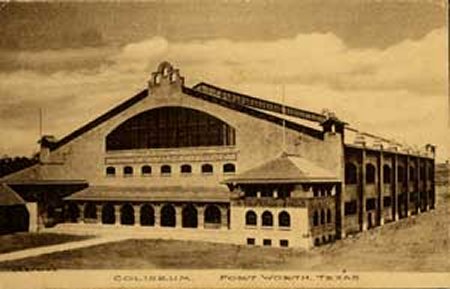
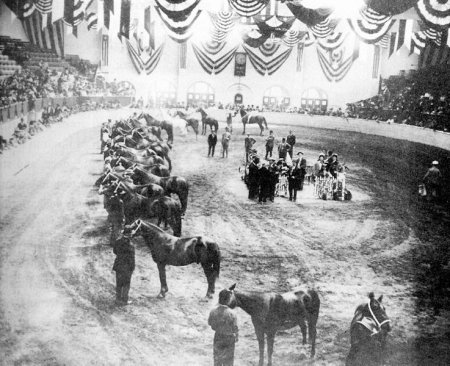
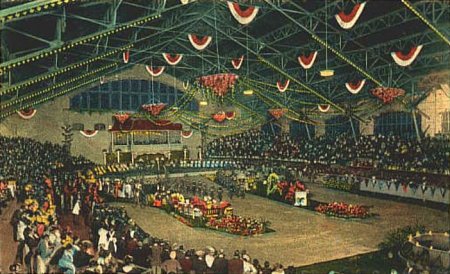
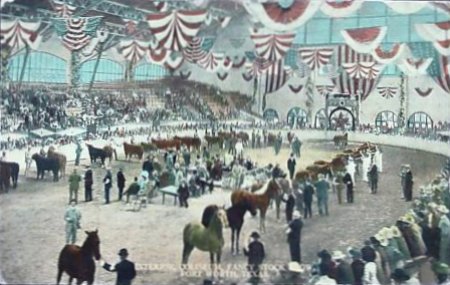
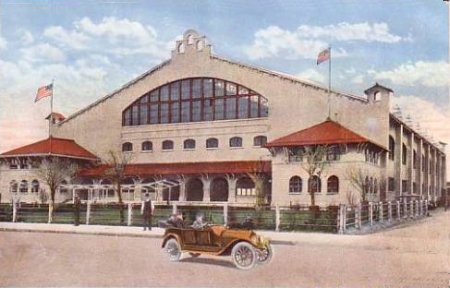
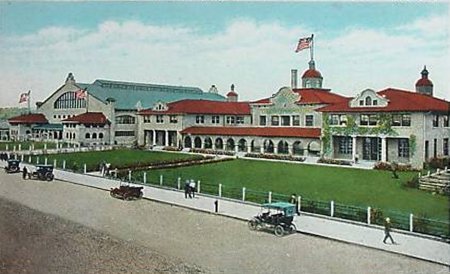
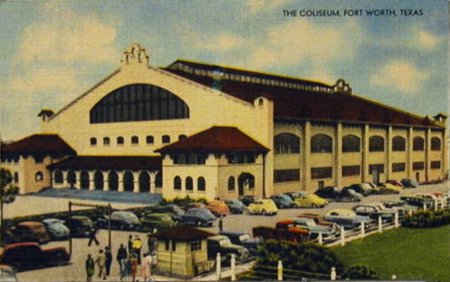
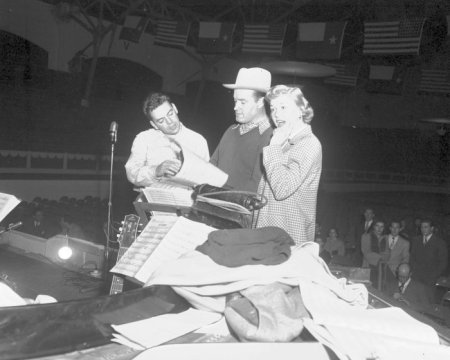

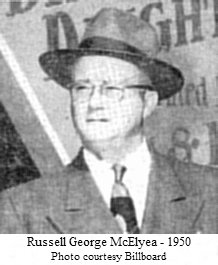





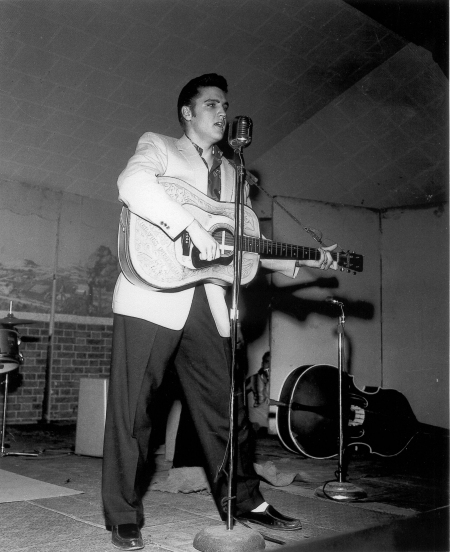
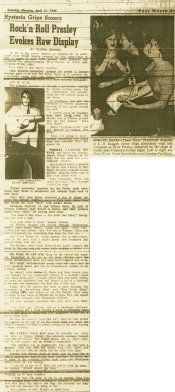 Hysteria Grips Soxers
Hysteria Grips Soxers